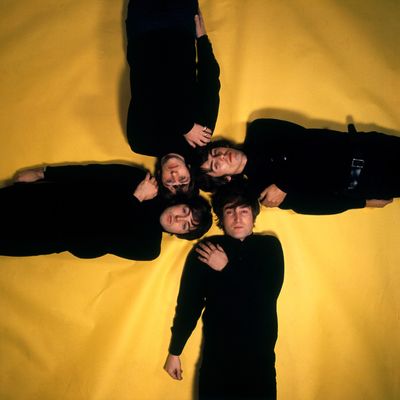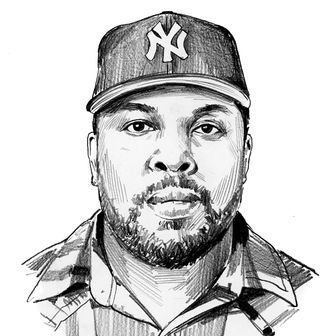
Part of what made the Beatles one of the quintessential pop acts of the 20th century was the marriage of sentimental songwriting, technological acuity, and tenacity in commerce. Their songs broke hearts in the crispest fidelity possible, and their fans showed appreciation by procuring mountains of officially licensed ephemera. Beyond the artistic and financial achievements, though, their musings on love and friendship were tested by wave after wave of adversity, from in-fighting to illness to death. To follow the Beatles through life is to believe that sweetness is stronger than the worst the world can throw at us. The endless trickle of archival Fab Four curios released since the band broke up in 1970 has always sought to reinforce this message while keeping diehards awash in memory and merchandise. The latest is “Now and Then.” Billed as “the last Beatles song,” the completed track offers one more cocktail of modern studio tech, warm nostalgia, and time-tested salesmanship.
The last time we were treated to what we believed to be the final recordings of the Beatles, Yoko Ono had given the remaining members a copy of late ’70s demos John Lennon recorded at the Dakota in Manhattan. In 1995, 25 years after breaking up, the band released the multimedia Beatles Anthology project, whose CD component was set to feature three songs fleshed out from the tape: “Free As a Bird,” “Real Love,” and “Now and Then.” “Free” and “Real” were gorgeous, uncanny songs, conversations between friends across decades you could hear in the gap between the quality of the sounds pulled from the tape and the ones surgically affixed to it. The video for “Free” predicted the form and concept of Gaspar Noé’s 2009 film Enter the Void: We drift through points of interest in the life of a dead man now meditating on having parted with his corporeal form. The presentation acknowledged something the person singing the songs wouldn’t know — he’s not long for Earth, and the melodic puzzles he’s untying at home right now will one day be received as capstones to his career, cherished last blueprints his old bandmates will finish building out.
But “Now and Then” languished in an unfinished state, its vocal and piano melodies enshrouded in too dense a thicket of abrasively scratchy hiss to massage into the high-quality recordings the Beatles were known for. In its afterlife, the band took on the role of the fourth-quarter classic rock closer freeing B-sides and updating the catalog to meet evolving audio standards, almost always around the holidays, a tradition initiated in 1970 with a Christmas compilation from the newly dissolved quartet that continued with the massive Thanksgiving 2021 Get Back release. This season’s spread includes the now AI-assisted completion of “Now and Then,” expanded editions of the 1962–1966 and 1967–1970 singles compilations from 1973, and a paperback edition of McCartney’s The Lyrics: 1956 to the Present, which first launched the same month as Peter Jackson’s 2021 documentary Get Back. The film is the north star for this campaign. The tech the director developed to isolate voices in old recordings in stunning clarity buffed the muddy Lennon vocal, accomplishing in seconds what stumped a few of the greatest musical minds of the 20th century a few decades prior. The finished “Now and Then” feels like something plucked from an alternate timeline.
What was once a yarn about clinging to a lover in a dark time has ballooned into a booming ballad that trades the demo’s pleasant if meandering bridge for a tasteful guitar solo topped off by a flurry of vocal harmonies that recall the cascading aah’s of Abbey Road’s “Because.” This foregrounds the stuff about missing someone and gestures to the grief inherent in McCartney and Ringo Starr playing around not just the posthumous recording of John but also the pieces George Harrison left behind when he died in 2001. Lennon’s vocal and piano are buttressed by gentle but busy band accompaniment, a patient strut paired with a string arrangement from McCartney, sometime Doctor Who orchestrator Ben Foster, and Giles Martin, son of the venerable producer George. It’s an anachronistic jolt not unlike Nirvana unveiling “You Know You’re Right” or Linkin Park finding “Lost.” It’s peak ’70s John, a tricky passage through foreboding thoughts and private fears, a fight for peace of mind in both melody and lyrics that contentment ultimately wins. It’s a document of a period when Lennon was understood to have put music on hold to raise a child and of the 25th anniversary-reunion that led to its rediscovery, a reality the Oliver Murray mini-doc accompanying the song acknowledges as it flits between footage of studio sessions in the ’60s, ’90s, and ’20s.
What would Lennon think? He let it languish. What would Harrison say? It frustrated him. Sir Paul seems sure they’d love the result, and few would know them better. But he’s supposed to say that. Finishing this song has been his quest. It’s his job to sell us on the brilliance of it. So the song coolly brushes aside the question of whether it should exist, paying for itself in pretty melodies, touchy choruses, and plush sonics. “Now and Then” returns to the well that yielded songs like “The Long and Winding Road,” journeying from darkness to light aided by delicate playing and orchestral flourishes. It imagines what the Beatles might have sounded like settling into the saccharine singer-songwriter ’70s together, bouncing vocal and lyrical ideas off each other in Lennon’s “Watching the Wheels,” Harrison’s “Blow Away,” and McCartney’s “My Love,” or a world where Starr’s 1973 album Ringo managed to get all four members on the same song instead of different ones.
The noise preventing “Now and Then” from being finished in the ’90s essentially being gone — barring a negligible bit of fuzz you could easily miss or mistake for an intentionally delicate phasing effect if you weren’t aware of the harshness of the original audio — is a triumph for machine learning in music at a time when the field desperately needs image reform. The worry that AI will extract the artist from the act of artistry is reinforced by every lofty scheme that aims to collapse the process between idea and execution because that’s a sexier sell than just offering tools to assist with and introduce people to the joys of making art. Imagine if the current discourse centered the possibilities of generative music for newer players and the time veteran producers save with vocal isolation and removal instead of which pop stars will make the best vocaloids. (Imagine the crusty recordings of great old performances that’ll benefit from the Beatles’ demonstration.) “Now and Then” uses a voice from the past to point toward that future. Whether or not the closure the single and the accompanying merch module and Peter Jackson mini-doc are serving this season will stick is anyone’s guess. “It’s probably, like, the last Beatles song,” McCartney says in the doc. (But “Carnival of Light,” the mythical 1967 improvisation he lobbied to place on Anthology remains in the wilds.) If this is the end of the Beatles, they have left us with a snapshot of their strengths.
Correction: A previous version of this review incorrectly stated the director of the “Now and Then” mini-documentary.


